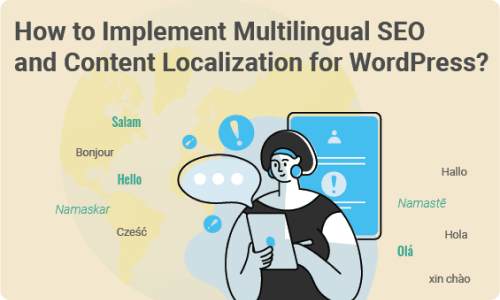WordPress SEO and Multilingual SEO go hand-in-hand to reach and attract your ideal customers. Indeed, many of your potential customers may or may not know about your business and language. However, did you know that people worldwide consume content on WordPress to keep up to date with the latest events? Unfortunately, your website could potentially be missing out on this traffic simply due to language barriers.
According to market research by Harvard Business Review, many MNCs depend on comprehensive local customer bases to efficiently expand into international markets. Local consumers visiting your website and engaging with your content will spread the word about your business presence. However, when you have a website that isn’t optimized well to attract your target audience, your new visitors may not be able to resonate with your message, website, and product or services. As such, in today’s article, we’ll be discussing the different ways to implement multilingual SEO on your WordPress website with ease. Also, we have summarized our thoughts on establishing a strong digital presence in multiple regions by overcoming language barriers on your website. So, without further ado, let’s take the first step towards multilingual SEO.
What is Multilingual SEO?
What is Multilingual SEO? Well, you use Multilingual SEO when you begin exploring different markets for your product. For example, let’s take a scenario where you want to optimize your website for the French audience. In this instance, the term “audience” indicates a broader stream of people and businesses than you might immediately assume. Indeed, France is not the only country to have French as its official language. Canada, Belgium, the Ivory Coast, and 28 other countries also have French as their official language.
Generally, we only optimize our websites for one language (most commonly English). However, by leveraging multilingual SEO, you’re able to optimize your content for multiple languages. As a result, your native website (most likely in English) now needs a French variant. Although multilingual SEO looks tricky, it’s certainly rewarding and provides countless benefits. On the other hand, you’re expanding your audience base and business into a completely new market that communicates in French.
Let’s start by discussing how you can implement Multilingual SEO strategies as follows:
Multilingual Website: To implement a multilingual website, we begin by setting up the website for multilingual use. This includes a few technical processes as follows:
Hreflang Tag: Duplicating your content without optimizing it for your target audience’s keywords hardly yields any results. Fortunately, there’s a technical tag, hreflang, that you can use to transform your current content. In turn, this allows you to create a multilingual website quickly and effectively. The hreflang tag instructs the search engine to show the translated content to users from specific regions and languages. The hreflang tag also helps with ranking these pages on Google Search and clearly instructs that these are not just duplicated content to search engines.
Landing Page: You can easily control which landing page a visitor should see first. Therefore, you can target both language and region with your choice of landing page.
Domain Strategy: With the help of ccTLD (Country Code Top-Level Domain), you can choose domains such as example.ca for Canadian websites, example.au for Australian websites, and so on. You could also go ahead with subdomains. For example, let’s assume you have a French website and you wanted to showcase your content in English for the US market. In this case, you could use example.com/en for English and example.com/ca for Canadian.
Multilingual Site Maps: To effectively allow search engines to crawl and rank your web pages without confusion, you need a sitemap. Plugins can help effectively manage your sitemap, but the manual process is more effective. When you manually alter the sitemap (under example.com/sitemap.xml), search engines can understand your website’s French, Russian, and Spanish versions in English.
Multiregional SEO: Multiregional SEO is a critical part of a multilingual SEO strategy. This is to target the French-speaking audience in the Ivory Coast and not the French-speaking audience in France.
Keyword Research: Though users from both the UK and the US speak English, the search queries often differ among them. So, identifying high-ranking keywords for each specific region or language is the overarching strategy here.
Translated Keywords: Identify your keywords and translate them to the desired language. In the process, you must ensure currencies, phrases, and measurements match the target language that you’re translating into.
Metadata: Your meta description, alt-texts, and social media image metadata for infographics or images can all help you rank on SERPs. So, don’t forget to use translated keywords in these crucial areas, as well as the main body of the text.
Translation: A global SEO strategy involves localizing your content to address the right target audience. It must not be limited only to localizing and translating the content. So, you must always ensure that you have implemented all the above-mentioned best practices. For example, when it comes to language, you need to understand the cultural difference in each country or region. Always pay attention to specific details, such as localizing the idioms and phrases native to that region and language.
What’s the Difference Between Localization, Internalization and Globalization?
Localization – The process of crafting relevant messages by keeping region-specific users in mind.
Internationalization – The process of launching a product or service that appeals to a larger part of the world. Content localization may come in handy to achieve this.
Globalization – An umbrella term encompassing localization, internationalization, multilingual SEO, and multiregional SEO. The same applies to content localization as well.
Wrapping up
A multilingual SEO approach comes in handy when you want to attract the right target audience for your website. Therefore, you must always understand the influence of content, language, and region on your target audience. Moreover, you should always take advantage of these factors strategically. While writing your content, keep your end-user in mind, and seek technical assistance to localize it if needed for the best results.
For further details and queries, feel free to send an email to info@engagebranding.com.



